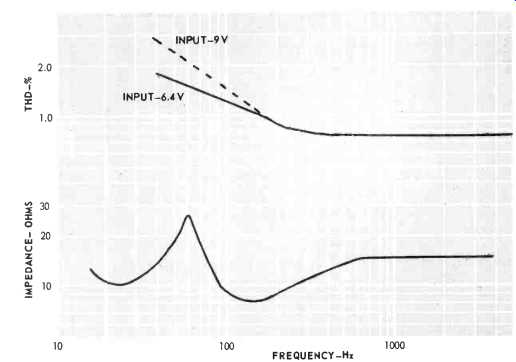
MANUFACTURER'S SPECIFICATIONS:
Impedance: 8 Ohms.
Dimensions: 23-5/8" x 12-3/4" x 10-15/16".
Weight: 33 Pounds.
Price: $99.95.
KLH's Model 33 is an excellent new speaker, which departs from conventional acoustic suspension by incorporating a 2-in. diameter ducted port in the front baffle. KLH calls it "controlled acoustic compliance" and it is so heavily damped that very little radiation occurs. What it does is smooth the impedance and control cone motion at the lowest frequencies.
The two-way system utilizes a 10-in. high compliance woofer having a 7-in. piston made of asphalt-impregnated paper and a 1.5-in. tweeter with a ceramic magnet. A metal screen protects the tweeter from prying fingers. The crossover frequency is just below 1500 Hz. A 3-position high-frequency level control, recessed into the rear of the enclosure, evenly attenuates the high end.
The oiled walnut cabinet, which is finished on all four sides, has a beaded front molding and a brown grille cloth, backed by black. These combine with the nice proportions to give a really appealing touch to this compact loudspeaker system.
The recessed input terminals and tweeter level control permit use of the speaker right up against the wall-either vertically or horizontally.
We measured frequency response by placing the speaker in a room horizontally, at sitting-ear height. The tweeter level control was set to NORMAL position.
Test signals of 1/3-octave pink noise were fed to the speaker at a level which caused the speaker to put out a SPL of 90 dB on-axis at three feet.
A second set of test readings was then taken at two 45-deg. off-axis positions and averaged. The third curve is an averaged plot of three off-axis and the on-axis response. It most closely represents the system's power response.

Fig. 1--Frequency-response curves measured 4 feet above the floor, horizontal
position.

Fig. 2--Toneburst response 300 Hz
As seen in Fig. 1, the frequency response of the Model 33 is excellent, averaging to ±3 dB over the entire range measured. The low-frequency variations are room effects and are to be disregarded.
The unit's impedance curve is shown in Fig. 3 and gives some clue as to the speaker's smoothness confirmed by white noise tests.

Fig. 3--Impedance and harmonic distortion.
Harmonic distortion measurements were made at 6.4-volt and 9-volt inputs, and are shown in Fig. 3. These represent approximate power levels of 5 and 10 watts, respectively, and show the low distortion of the woofer. At 40 Hz, for example, the distortion was less than 2 per cent at 5 watts. We consider 40 Hz to be the low-frequency limit of this speaker.
Efficiency of the KLH 33 is average relative to acoustic suspension speakers as a whole. We recommend using an amplifier with 30 watts of available power ( rms) per channel. There is no problem in using a much more powerful amplifier either. In fact the speaker system can handle 90-watt bursts without noticeable distortion.
Oscilloscope photos of tone bursts are shown in Fig. 2. They confirm the fine transient response of the speaker.
Listening tests conformed closely to our test data. The high end was there and evenly dispersed into most parts of the room, resulting in a very transparent quality, easy to listen to. Only the lowest frequency fundamentals present on some materials were subdued. Otherwise the bass was unusually clear and tight for such a small box. We would favor this speaker in a moderately priced installation. Another nice product from KLH. Congratulations, Victor Campos.
-A.R.
(Audio magazine, Dec. 1970)
Also see:
KLH Model Fifty-Two Stereo Receiver (Equip. Profile, Aug. 1973)
= = = =